Structural Mechanics in Reactor Technology 23
10-14 August 2015; The Lowry, Manchester
Chair Dave Shepherd reflects on the success of the 23rd edition of the bi-annual SMiRT Conference series held in Manchester last August after a forty year long period of absence from the UK.
For those who who may not know, SMiRT stands for Structural Mechanics in Reactor Technology and is a major international conference that has been running every alternate year since its inception in 1971. The conference was initiated by Thomas Jaeger under the auspices of the Commission of the European Communities, Bundesanstalt für Materialprüfung (BAM), and held initially in Berlin.
From the outset the conference language has been English and there has been a substantial UK involvement, however the only previous time the conference was held in the UK was in 1975 at Imperial College. It was therefore a massive privilege for me to be the Chairman of the conference’s long-overdue return to the UK in August this year.
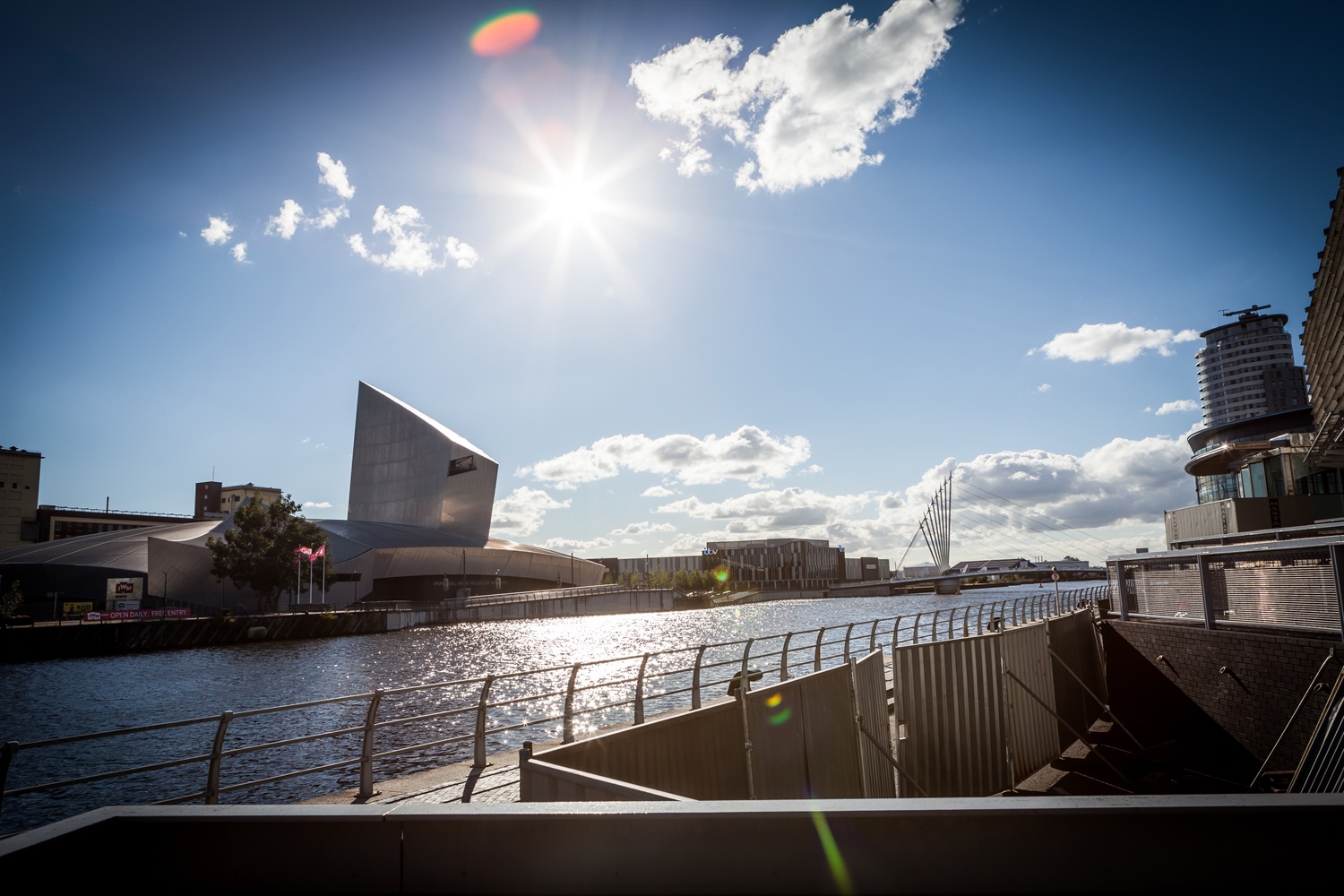
Organisation
The SMiRT conferences became independent of EC sponsorship from the late 1980s and since then the top level governance is provided by a not-for-profit organisation formally based in Germany and called the International Association of Structural Mechanics in Reactor Technology – IASMiRT. Each conference is self-funding and independently organised by a local team. The conference is arranged around ten established disciplines (such as modelling, loading, materials) but with a diverse representation from all aspects of the nuclear industry encompassing academia, government laboratories, industry and suppliers, operators and regulators - and from the full spectrum of the nuclear industry encompassing reactors, chemical plant, spent fuel storage and naval facilities.
The aspiration is for the meeting to rotate between Europe, the Americas and Asia. During the last European conference (SMiRT 20 in Helsinki in 2009) I started to investigate the possibility of bringing the next European conference to the United Kingdom. I canvassed six organisations that I thought were representative of the UK industry and found that each was enthusiastic then and, I am very pleased to say, has remained enthusiastic and provided the organisational heart of SMiRT 23 all the way through. They are:
- Amec Foster Wheeler
- EDF Energy Generation
- NAFEMS
- Nuclear Institute
- University of Manchester and
- Office for Nuclear Regulation
Having consolidated the ambition to hold the conference these organisations agreed to form the Local Organising Committee (LOC) and representatives from the full team attended SMiRT 21 in India in 2011, where our bid to host SMiRT 23 in the UK was resoundingly successful. The IASMiRT Board commented that the UK bid was one of the best they had ever seen – and from then on the real work started!
Each of the key organisations has provided their own expertise, insights and commitment over the last five years and I am really proud that the initial concept of shared responsibility delivered so effectively. Amec Foster Wheeler and EDF Energy Generation have to be highlighted as providing an undertaking to support the finances for the conference, with the Nuclear Institute as contracting party. However each of the six organisations shared the responsibility and commitment for delivering an amazing conference – as described below.
One of the first significant decisions the LOC had to make was the conference venue. After reviewing a short list of possible venues in London and the North West we overwhelmingly agreed that the best venue was The Lowry, at Salford Quays, Manchester. There were several reasons for this, including overall cost, recognition that the centre of gravity for the contributing organisations is the North West, but mainly the inspirational feeling we all shared when we visited the Lowry and held discussions with their highly committed and professional staff. It is an amazingly interesting building with, importantly for SMiRT 23, a range of rooms each with excellent audio-visual and IT facilities. The main theatre, The Lyric, provided a superb venue for the opening and closing sessions and the main plenaries.
Having settled on the Lowry for the conference the decision regarding the venue for the traditional conference dinner was easy – once it was apparent that Manchester Cathedral was available and was capable of accommodating the 500 or more delegates we were expecting. In the event the number of delegates at the dinner was approaching 600 and the Cathedral provided a memorable evening for the event.
Papers and countries
SMiRT has always been a conference based around papers presented by individual delegates, enriched by a number of invited plenary lectures and organised workshops and panel discussions. SMiRT 23 was no exception with over 500 papers from 31 countries (figure 1). The sheer numbers are important but what is more significant is the quality of the papers, which was well up to SMiRT’s high standards. A selection of papers will be fully peer reviewed and published in a special edition of Nuclear Engineering and Design and all the papers will be available on the IASMiRT website in the near future – see iasmirt.org.
Plenary lectures
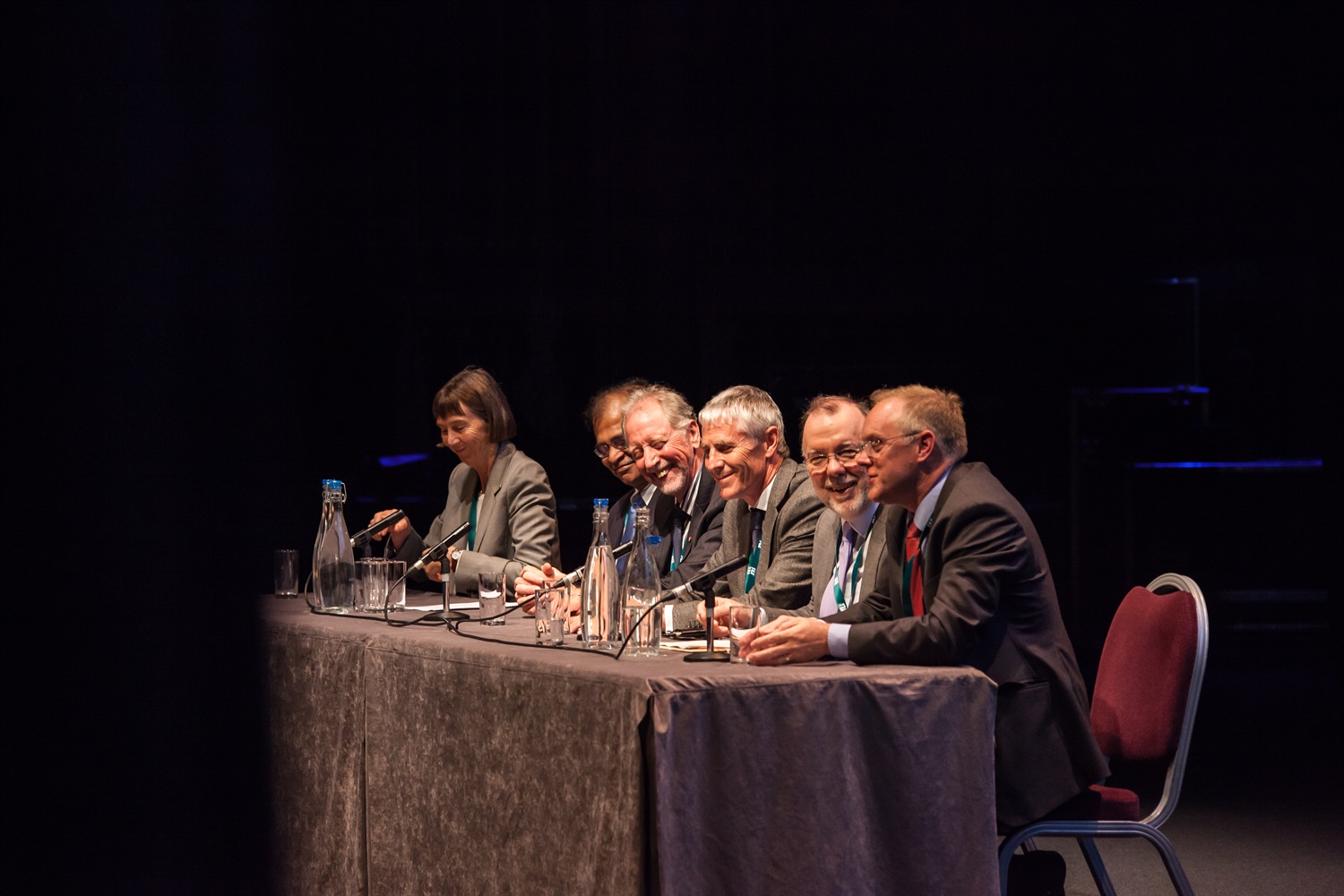
The opening day of the conference was dedicated mainly to invited plenary speakers and the UK industry supported us wholeheartedly with extremely interesting lectures from across the industry.
Bob Ainsworth
University of Manchester
Jaeger Lecture - Defect Tolerance Arguments in Demonstrating the Structural Integrity of Nuclear Power Plant Components.
David Boath
Vice President, Amec Foster Wheeler Clean Energy
Nuclear sustainability through collaboration.
Stuart Crooks
Managing Director, EDF Energy Generation
Safe reliable nuclear generation over extended lifetimes: an operator perspective
Andy Hall
Chief Nuclear Inspector, Office for Nuclear Regulation
The challenge of regulating the nuclear industry in the UK
Dame Sue Ion
Chairman of the UK Nuclear Innovation Research Advisory Board (NIRAB)
Realising Nuclear Energy’s True Potential- Reaching Beyond the Challenges of Today
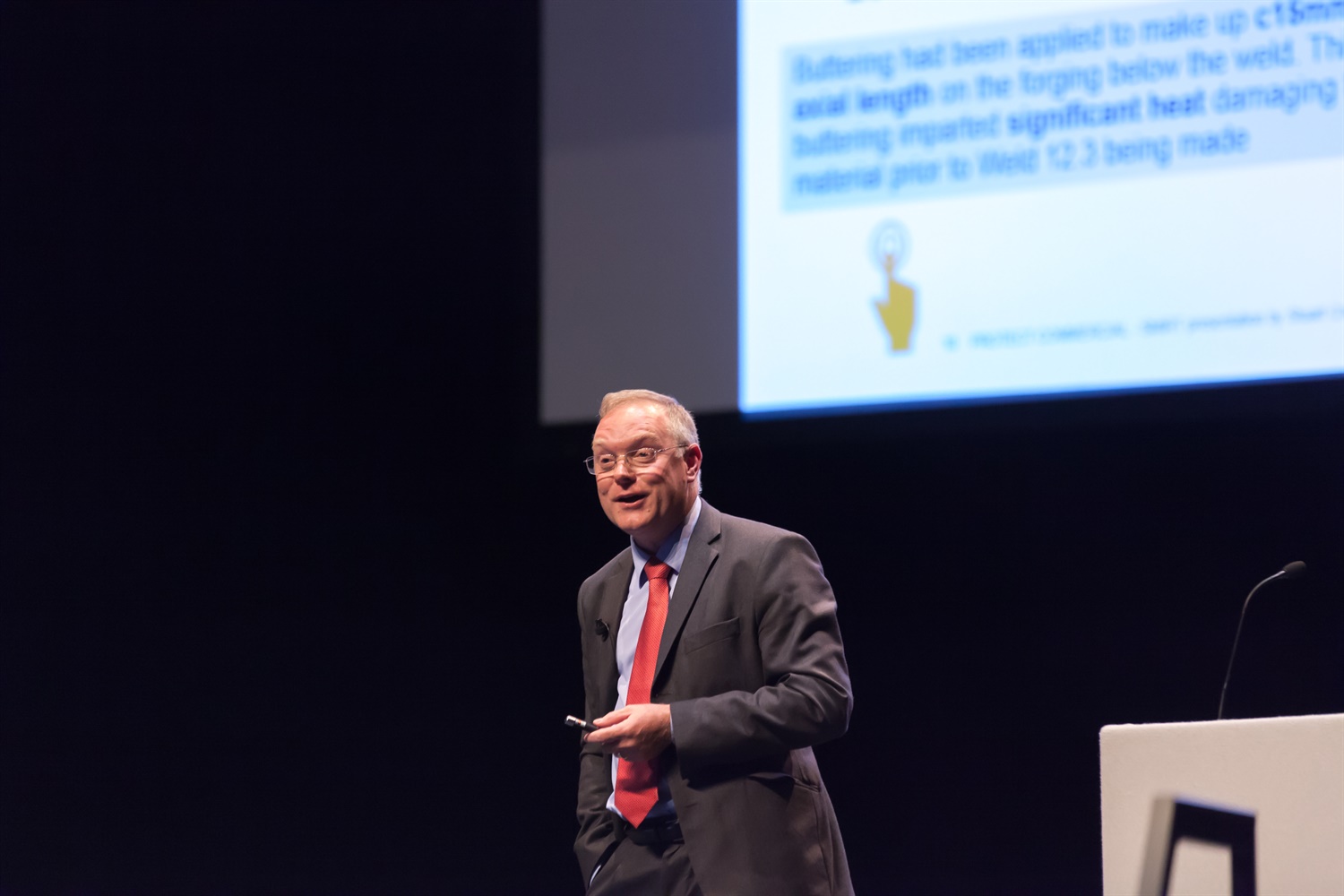
Stuart Crooks, Managing Director, EDF Generation
There is no doubt this range of talks gave a great impression of UK’s commitment and capabilities in regard to nuclear power engineering and opened the eyes of many of the conference delegates to the substantial history of nuclear power in the UK and its potential for the future. The style of highly professional yet informal talks also set a highly constructive tone for the rest of the conference.
Panel and workshop sessions
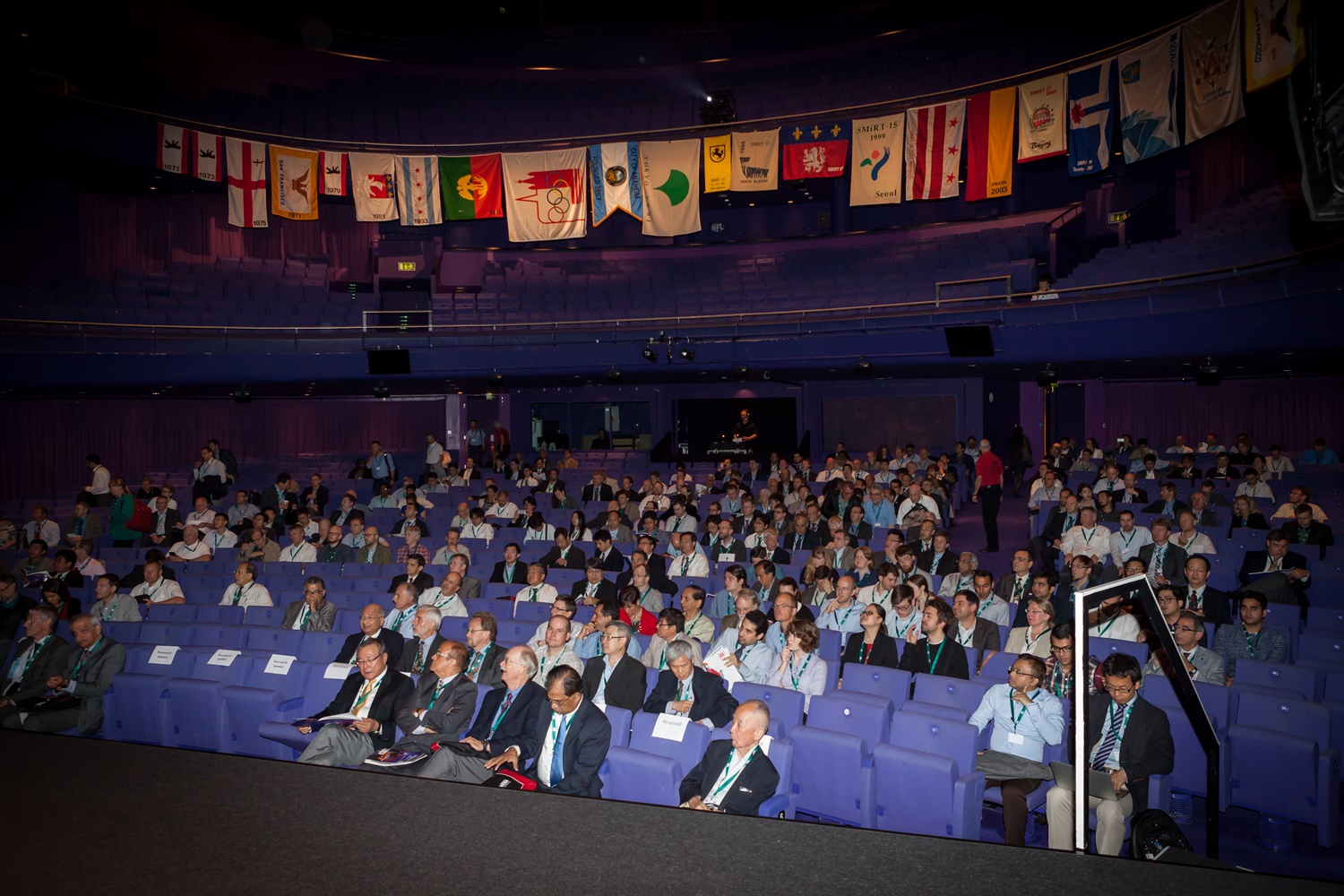
In addition to the rich technical interactions generated from the delegate’s papers and the invited plenaries we had twenty-three pre-organised workshops and panel sessions that set a focus on important topics of current interest. A real testament to international collaboration most of these were supported by substantial input from the UK including:
|
Workshop on nuclear applications of graphite
|
Organised by Jim Reed of EDF Energy
|
|
Workshop on lifetime management of AGR plant
|
Organised by Dave Dean of EDF Energy
|
|
Flooding Hazards – Developments Post-Fukushima
|
Organised by Abhinav Gupta of USA with input from Peter Ford of ONR.
|
|
Panel session on small modular reactors
|
Organised by Nawal Prinja of Amec Foster Wheeler with input from Tim Abram of the Dalton Institute.
|
|
Panel session on new build and harmonisation of codes and standards
|
Organised by Andrei Blahoainu of Canada with input from Nawal Prinja of Amec Foster Wheeler
|
|
Panel on future perspective in NPP material ageing
|
Organised by Prof Soneda of Japan with input from Jon Hyde of NNL and Gareth Hopkin of ONR
|
|
Workshop on high density polyurethane piping
|
Organised by Claude Faidy of France with input from Craig Oglesby of Plasflow and Paul Jones of Exova.
|
|
UK forum for engineering structural integrity
|
Organised by John Sharples of Amec Foster Wheeler
|
|
Panel session on engineering analysis and simulation competency
|
Organised by Prof Jim Wood of NAFEMS and University of Strathclyde.
|
|
Panel on risk informed regulatory framework for external hazards
|
Organised by Nilesh Chokshi of USA with input from Peter Ford of ONR
|
|
Panel on NUGENIA and integration of national R&D programmes
|
Organised by Elisabeth Keim of France with input from John Sharples of Amec Foster Wheeler
|
|
Panel on concrete degradation mechanisms
|
Organised by Prof Neb Orbovic of Canada with input from Michael Johnston of EDF Energy
|
Social programme
With delegates travelling from around the world many bring partners and families and a great range of interesting visits was provided to help them make the best of their time in the Manchester area. Accompanying person’s visits included Liverpool, Chester and Lyme Park and an opportunity for Delegates to visit Heysham 2 nuclear power station was fully subscribed. The Lowry provided free entry for delegates for a musical event on the Tuesday evening of the conference and, as already mentioned above, the highlight of the social programme was the conference dinner at Manchester Cathedral on the Thursday evening. A magnificent dinner was followed by an opportunity for delegates and their guests to enjoy some spirited dancing to the sounds of Redwood a great band all the way from Ireland for the occasion.
Outcomes
It is very difficult to distil the outcome of an intense five-day conference in a few words – especially as most of the time there were at least eleven sessions all taking part in parallel! One thing that was apparent right from the opening “ice-breaker” reception on Sunday afternoon through to the closing ceremony on Friday lunchtime was that the venue absolutely worked. There was no doubting the real buzz of interactions between delegates and the large number remaining to attend sessions even on the last day was testament to the success of the planned programme.
The diversity of attendees was also a remarkable success. As explained above around 600 experts from over 30 countries took part and a glance at the attendance breakdown in figure 2 will show that not only were the well-established “nuclear” countries such as France, USA and Japan well represented, but also some relatively in-experienced countries. Among the “others” in the pie chart are countries such as UAE, Singapore and Turkey. Turkey in particular is intending to learn from SMiRT and they have their own seminar along SMiRT lines organised for later this year. Given the political status of the industry in Germany the number of delegates from that country was remarkable and it is very satisfying that SMiRT 23 provided a forum for German engineers to retain and share their expertise.
The well-established practice for SMiRT conferences is for the technical programme to be developed by an International Scientific Committee comprising several experts for each of the ten SMiRT divisions. For SMiRT 23 this team was developed and led by Manus O’Donnell from EDF Energy Generation with Nawal Prinja as the co-chair. The support from UK and international individuals was superb and the technical programme is a tribute to their dedication and efforts.
The complexity of delivering eleven parallel sessions over the course of a week is far from trivial and one of the most rewarding periods of the day was the early morning meeting managed by the ISC team where the individual session chairs and co-chairs were briefed and prepared for the day’s work. There is no doubt that this attention to detail provided a cohesiveness that contributed massively to the success of the conference.
The over-arching theme of the conference was “using existing challenges to champion the next generation” and it was very gratifying that we had 55 student registrations plus many from engineers and academics in the early phase of their careers. One of the new initiatives associated with this theme was an award for the best paper written and delivered by an individual within ten years of starting their professional career. The award, which includes a cash prize and free registration to SMiRT 24 in Korea in 2017, was deservedly won by Peter Gill at Amec Foster Wheeler with his paper “A method to Assess Impact Damage using a Smoothed Particle Hydrodynamics and Finite Element Coupled Approach”. Congratulations to Peter and all those who took part in the competition. An additional initiative consistent with the conference theme was “an hour with an expert” where informal meetings were arranged in small groups to promote knowledge transfer between more experienced participants and individuals nearer the start of their careers.
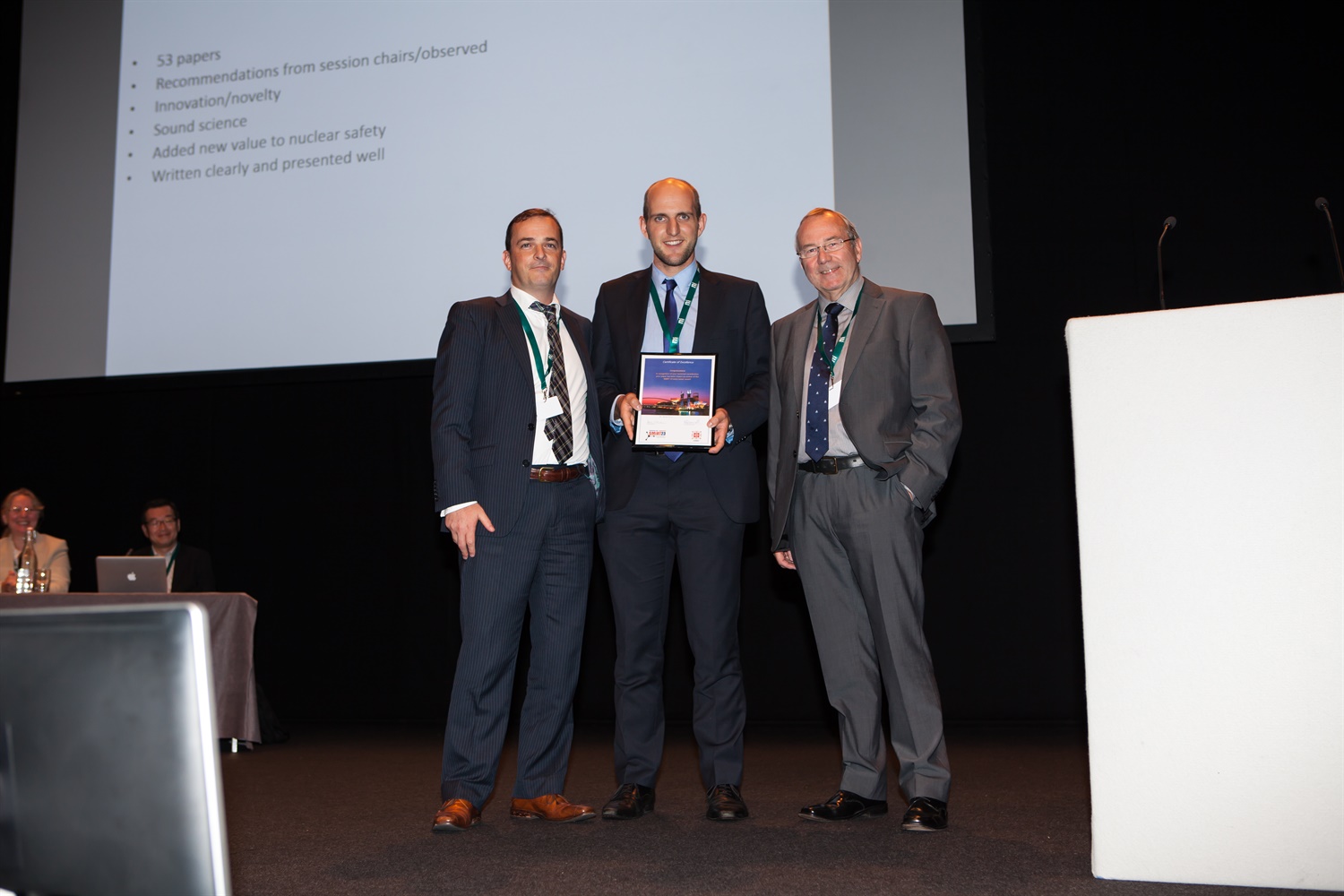
(l-r) Manus O'Donnell, EDF Energy; Peter Gill, Amec Foster Wheeler, winner of the SMiRT23 Eary Career Award; and Dave Shepherd, Chair of SMiRT23
I am also incredibly impressed by the commitment of literally dozens of engineers and academics who so generously gave their time to generating such exciting workshops and panel sessions. The list above is by no means exclusive, and in no way can a list provide an insight into the depth and quality of discussions generated. I know that all those who took part will have taken away a fresh insight into these important and relevant issues.
Finally I know from the many individuals I met and held discussions with throughout the week that the conference was exceptionally well received and it generated a massively positive impression of the UK industry and its capabilities.
Thanks
Of course all this was achieved only because of the determination and hard work of a large number of people. It is not possible to thank every individual personally but I think it is fair for me to summarise the organisations that formed the core of the organising committee and mention a few of the principal individuals, many of whom are members of the Nuclear Institute
From Amec Foster Wheeler Nawal Prinja was deputy chair of the International Scientific Committee and Matt Dawber managed the overview of the technical programme.
From EDF Generation Manus O’Donnell was chair of the International Scientific Committee and the driving force behind delivery of the programme, ably supported by Rachael Macartney, Christine Waata and Harris White.
EDF and Amec were the major sponsors of the conference and without their support hosting the conference in the UK would not have even been contemplated.
NAFEMS, via Tim Morris and Jo Davenport, contributed massively by organising financial sponsorship and providing valuable insights into the finance planning overall.
The Nuclear Institute were fundamental to the delivery of the conference and were the contracting party throughout, providing all the conference services such as managing registrations, printing and contracting with the venues etc. Madhu Madhavi was our main representative supported by many others from NI as the need arose, including the current Chief Executive John Warden.
ONR was one of the initiating organisations and despite substantial re-organisations during the course of the conference planning maintained a substantial level of commitment, with Peter Ford contributing to both the local organising committee and the International Scientific Committee.
University of Manchester hosted many of the important scientific committee meetings and student volunteer provided much-needed help during the week, all co-ordinated by Chris Race with Andrej Jivkov taking on the role of guest editor for the special edition of NED.
I also have to thank my wife Sonia who took the lead on the social programme and provided support to many of the conference activities.
It has been hard work for all of us for many years, with some substantial challenges along the way. Thanks to all of those above who provided a great team to address those challenges. It has been a great experience and extremely satisfying to reflect on the fact that SMiRT 23 came to the UK in 2015 and was such a great success.
Dave Shepherd
Chair SMiRT 23 and President IASMiRT